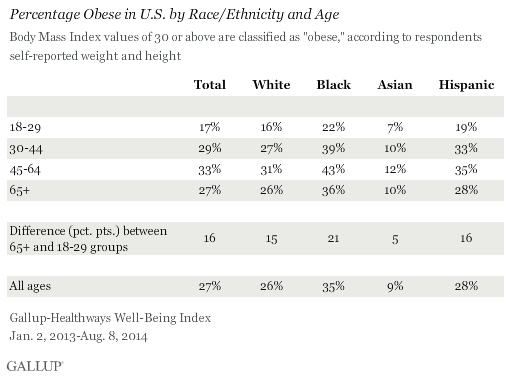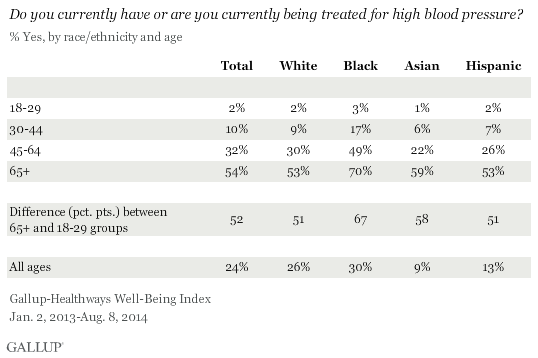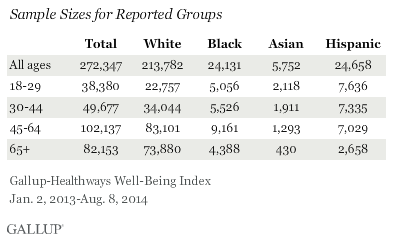Story Highlights
- Obesity peaks in middle age for all major racial/ethnic groups
- Hypertension and high cholesterol peak after age 65
- Blacks most likely to be obese, have hypertension
WASHINGTON, D.C. -- Older Americans generally are more likely than their younger counterparts to be obese, with the rate peaking in middle age and then declining around retirement age. But for blacks in particular, obesity rates show even greater differences by age group. Between the ages of 18 to 29 and 45 to 64, blacks' obesity rate ticks up 21 percentage points, compared with 16 points for Hispanics, 15 points for whites and five points for Asians.

Overall, in Gallup-Healthways Well-Being Index data captured from Jan. 2, 2013 through Aug. 8, 2014, 27% of Americans are obese. Across the four major racial and ethnic groups, blacks have the highest obesity rate (35%) and Asians have the lowest (9%) -- a pattern that has been consistent over time.
These results are based on interviews with more than 272,000 Americans conducted as part of the Gallup-Healthways Well-Being Index. The resulting sample sizes for each racial and ethnic group allow for a granular look at how obesity and other chronic diseases progress with age.
The Well-Being Index uses respondents' self-reports of their height and weight to calculate standard Body Mass Index (BMI) scores. Individual BMI values of 30 or above are classified as "obese."
High Blood Pressure Jumps Among Seniors, Especially Blacks
Unlike obesity rates, which hit their peak in middle age and then decrease among those older than 65, hypertension continues to be significantly more common among seniors. Young Americans start out on a relatively even playing field in terms of hypertension, with similar, very low, rates across all 18- to 29-year-olds. But by middle age, nearly half of blacks report having hypertension -- roughly double the rates of Asians and Hispanics in the same age group. An even higher 70% of retirement-age blacks have or are being treated for high blood pressure, significantly greater than the rates seen for all other groups.

High Cholesterol Elevated Among Older Age Groups, Regardless of Race or Ethnicity
Unlike hypertension, the percentage of adults reporting that they currently have or are currently being treated for high cholesterol is similar by age across all major racial and ethnic groups. Among those aged 45 to 64, whites and blacks (24%) are somewhat more likely to report high cholesterol than are their Asian or Hispanic counterparts. There is no gap by racial or ethnic group among those aged 65 and older, however, with all four groups at or within two points of the national level of 39%.

Implications
Blacks in older age groups are significantly more likely than other Americans to be obese and report having high blood pressure. This begs the question of what factors beyond genetics contribute to this pattern. Given that blacks, on average, earn a lower household income than whites, income seems to play a role. Having a lower income and the presence of more food deserts have additively been linked to obesity, a factor that would also be relevant to Hispanics.
In addition, blacks are second only to Hispanics in being uninsured, making accessing and paying for available healthcare a challenge. And the U.S. healthcare system largely focuses on treating illnesses instead of preventing them in the first place, an approach that may perpetuate incidences of chronic disease as many people do not have the tools and support to avoid these conditions. Further, early education programs tailored toward improving health and well-being are lacking in the U.S., particularly within impoverished communities.
However, a movement in healthcare known as "lifestyle medicine," which teaches individuals and populations how to reverse and prevent chronic disease through lifestyle modification, is gaining ground. Dr. Dean Ornish, founder of the Preventive Medicine Research Institute and thought leader in advocating preventive lifestyle measures as treatment, says, "The most common chronic diseases -- including high blood pressure, elevated cholesterol levels and heart disease -- have a common root cause: the lifestyle choices that we make each day. Most doctors prescribe a lifetime of medications to treat these conditions, but comprehensive lifestyle changes can prevent and even reverse them."
The lifestyle modifications typically consist of strategies addressing diet, exercise, stress reduction and increased social support. Given the comparatively high prevalence of these chronic conditions among blacks and the socio-economic factors driving these high rates, a lifestyle approach that allows individuals to take their health into their own hands could be extremely beneficial.
While not all American adults will fall into one of the high-risk categories for obesity, high blood pressure or high cholesterol, these conditions affect everyone, as soaring healthcare costs account for about 17% of the United States' GDP. Ultimately, long-term improvement in the rates of these illnesses partially rests on addressing the underlying factors contributing to the racial disparities in chronic condition rates. Tackling the root causes of these illnesses and empowering people to manage their own health will benefit individuals and the overall U.S. economy.
Survey Methods
Results are based on telephone interviews conducted Jan. 2, 2013-Aug. 8, 2014, as part of the Gallup-Healthways Well-Being Index survey, with a random sample of 272,347 adults, aged 18 and older, living in all 50 U.S. states and the District of Columbia. For results based on the total sample of each reported subgroup, the margin of sampling error ranges between ±0.5 and ±5.8 percentage points at the 95% confidence level. (See the table for full sample sizes.) In most cases, the margin of error is no more than ±1.5 points. All reported margins of sampling error include computed design effects for weighting.

Each sample of national adults includes a minimum quota of 50% cellphone respondents and 50% landline respondents, with additional minimum quotas by time zone within region. Landline and cellular telephone numbers are selected using random-digit-dial methods.
Learn more about how the Gallup-Healthways Well-Being Index works.

